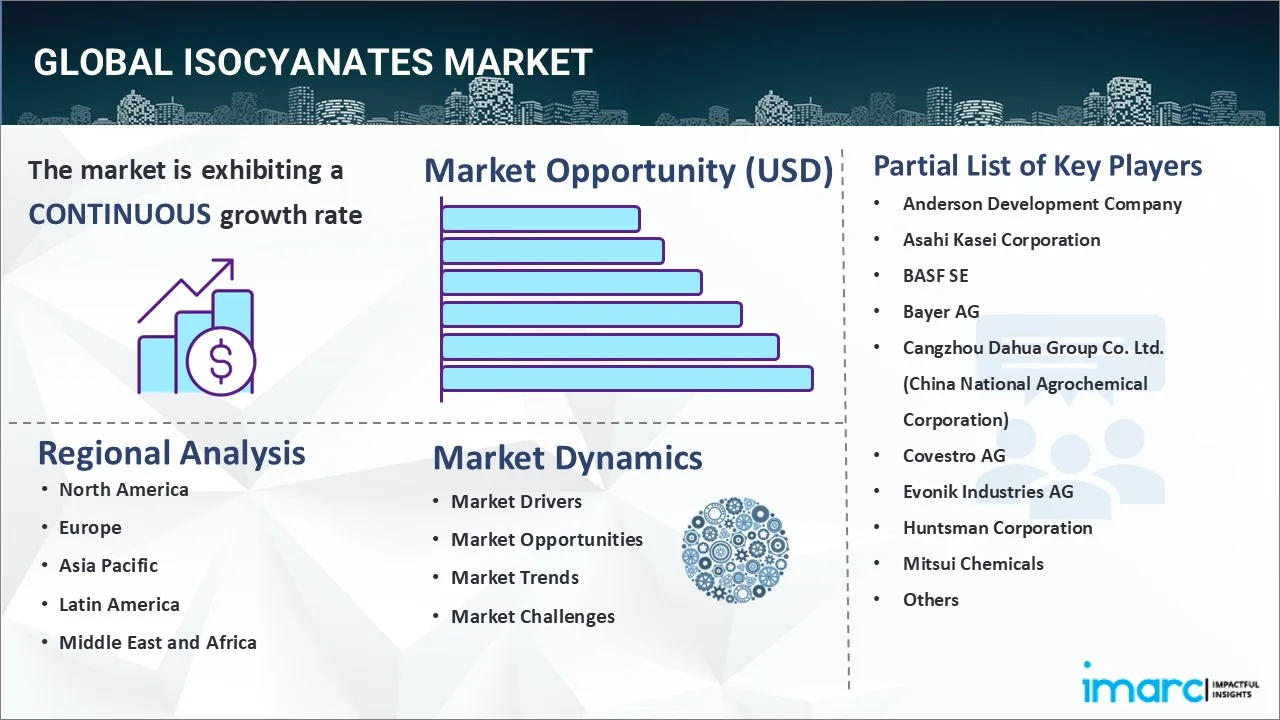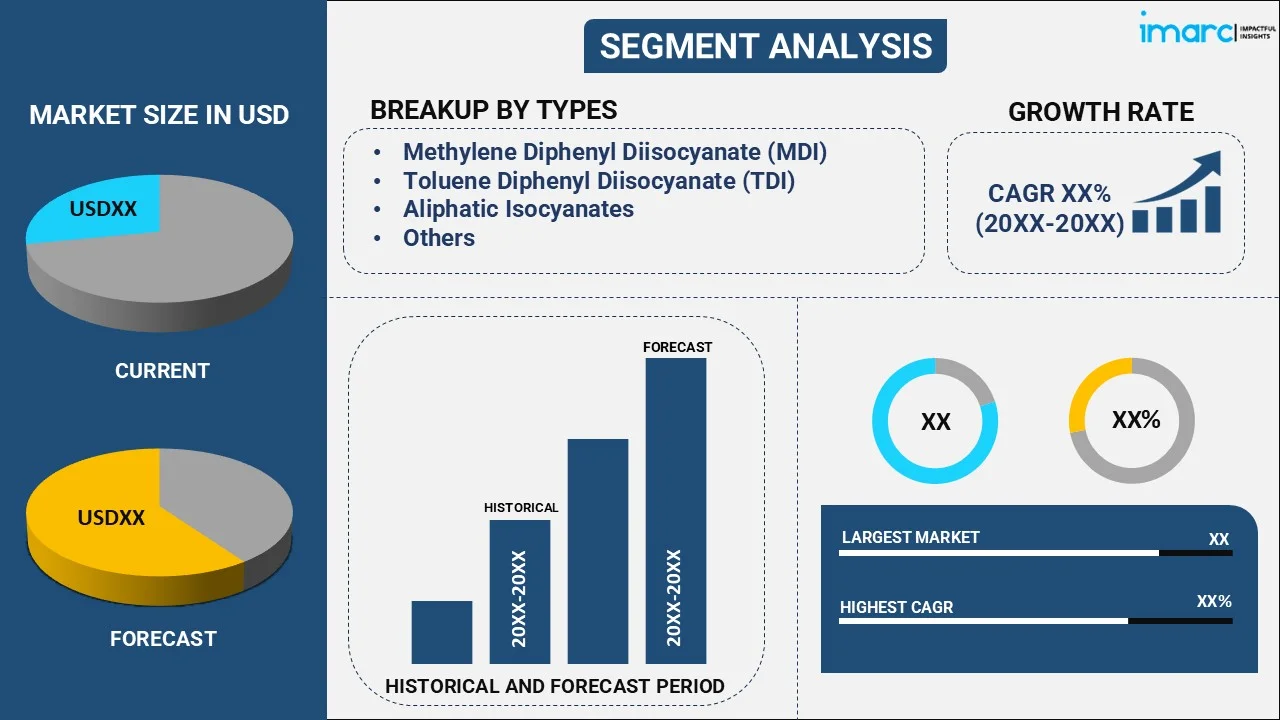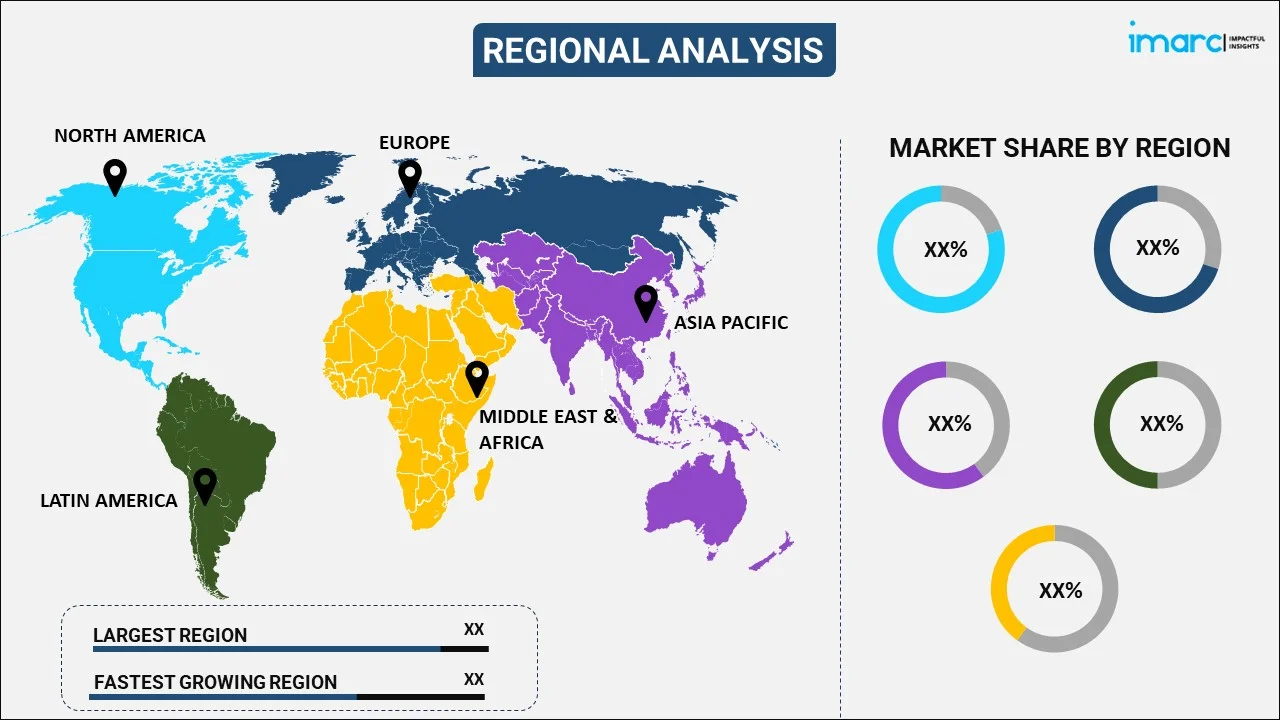
Isocyanates Market Report by Type (Methylene Diphenyl Diisocyanate (MDI), Toluene Diphenyl Diisocyanate (TDI), Aliphatic Isocyanates, and Others), Manufacturing Process (Phosgenation Process, Nonphosgenation Process), Application (Rigid Foam, Flexible Foam, Paints and Coatings, Adhesives and Sealants, Elastomers, Binders, and Others), End-Use Industry (Building and Construction, Automotive, Healthcare, Furniture, and Others), and Region 2025-2033
Global Isocyanates Market Size:
The global isocyanates market size reached USD 32.1 Billion in 2024. Looking forward, IMARC Group expects the market to reach USD 50.9 Billion by 2033, exhibiting a growth rate (CAGR) of 5.2% during 2025-2033. The increasing demand for polyurethane in various applications, technological advancements, rising use in construction and automotive industries, growing energy efficiency standards, economic development in emerging markets, rapid urbanization, infrastructure development, and rising industrialization are some of the key factors stimulating the global market for fire alarm and detection systems.
|
Report Attribute
|
Key Statistics
|
|---|---|
|
Base Year
|
2024
|
|
Forecast Years
|
2025-2033
|
|
Historical Years
|
2019-2024
|
|
Market Size in 2024
|
USD 32.1 Billion |
|
Market Forecast in 2033
|
USD 50.9 Billion |
| Market Growth Rate 2025-2033 | 5.2% |
Global Isocyanates Market Analysis:
- Major Market Drivers: The increasing demand for polyurethane products in the various end-use industries such as automotive, construction, and consumer goods industries, coupled with technological innovations enhancing product applications, global economic growth, particularly in emerging markets, and the rising focus on energy-efficient materials leading to increased use of isocyanate-based insulations and foams.
- Key Market Trends: The widespread adoption of green and sustainable manufacturing processes, the rising development of non-toxic and low-emission isocyanate products, the increasing demand for bio-based polyurethanes, and the rising shift towards energy-efficient construction materials are the key trends in the isocyanates market. There’s also a growing focus on innovation in recycling and reusing polyurethane materials which represents one of the key market trends.
- Competitive Landscape: Some of the major market players in the global isocyanates industry include Anderson Development Company, Asahi Kasei Corporation, BASF SE, Bayer AG, Cangzhou Dahua Group Co. Ltd. (China National Agrochemical Corporation), Covestro AG, Evonik Industries AG, Huntsman Corporation, Mitsui Chemicals, The Dow Chemical Company, and Wanhua Chemical Group Co. Ltd., among many others.
- Geographical Trends: Asia Pacific accounted for the largest region for the isocyanates market, on account of rapid urbanization and industrialization. The increasing construction activities, along with the automotive and construction sectors are acting as major growth-inducing factors in the market.
- Challenges and Opportunities: The market is experiencing several challenges, such as rising environmental and health concerns, regulatory compliance, fluctuation in the prices of raw materials, and competition from bio-based alternatives. However, innovations and technological advancements, the growing demand in emerging markets, and the rising shift toward energy efficiency and sustainability are creating opportunities for the market growth.

Global Isocyanates Market Trends:
Growing Demand from Various End-Use Industry
The extensive use of isocyanates in various industries, including construction automotive, coatings, furniture, and electronics represents one of the key factors influencing the growth of the isocyanates market across the globe. The growing automotive sector, driven by the rising vehicle production and demand for lightweight, durable materials, is further driving the demand for isocyanates. According to the trading economy, car production in the United States increased to 10.78 million units in February from 10.58 million units in January of 2024. The increasing construction activities, especially in emerging economies, are fueling the demand for polyurethane-based products, which use isocyanates as a key raw material, thus bolstering the market growth. According to the Construction Association, there were more than 9,19,000 construction establishments in the United States in the first quarter of 2023. The industry employs 8.0 million employees and creates nearly $2.1 trillion worth of structures each year which is expected to drive the isocyanates market statistics.
Significant Advancements and Innovations in Technologies
The rising technological advancements and innovations are acting as major growth-inducing factors in the market across the globe. The increasing research and development (R&D) activities directed at enhancing the properties and performance of isocyanate-based products are leading to the introduction of new applications and formulations which is boosting the market growth. For instance, in 2023, Bayer AG invested 220 million euros to build a new research and development (R&D) center at the Monheim site, which is strengthening its commitment to sustainable agriculture. This is further driving the isocyanates market recent developments. For instance, in March 2024, Covestro inaugurated its first plant that can produce polycarbonate copolymers on an industrial scale at its Antwerp, Belgium site. The company’s new platform technology is based on an innovative, solvent-free melt process in combination with a new reactor concept. This is further expected to fuel the market growth.
Rising Demand for Bio-Based Isocyanates
The market is also driven by the increasing focus on sustainability and environmental conservation which is boosting a shift towards bio-based isocyanates derived from renewable feedstocks, such as vegetable oils and biomass. The increasing implementation of strict regulations by governments in various countries across the globe to limit emissions and promote sustainable practices is driving the adoption of bio-based Isocyanates. The rising consumer awareness regarding the environmental impact of conventional isocyanates is driving the demand for greener alternatives, which is facilitating the growth of the market. For instance, in 2022, BASF expanded the portfolio of methylene diphenyl diisocyanate (MDI) and introduced Lupranat ZERO (Zero Emission, Renewable Origin) the first greenhouse gas-neutral aromatic isocyanate. Lupranat ZERO has an accounting Cradle-to-Gate1 Product Carbon Footprint2 (PCF) of zero, which means that on its way until it leaves the BASF factory gate for the customer - all product-related greenhouse gas emissions and the biobased carbon bound in the product taken together - it does not carry a CO2 backpack. This is further boosting the isocyanates market share across the globe.
Global Isocyanates Market Segmentation:
IMARC Group provides an analysis of the key trends in each segment of the market, along with forecasts at the global, regional and country levels for 2025-2033. Our report has categorized the market based on type, manufacturing process, application, and end-use industry.
Type Insights:

- Methylene Diphenyl Diisocyanate (MDI)
- Toluene Diphenyl Diisocyanate (TDI)
- Aliphatic Isocyanates
- Others
Methylene Diphenyl Diisocyanate (MDI) dominates the market
The report has provided a detailed breakup and analysis of the market based on the type. This includes methylene diphenyl diisocyanate (MDI), toluene diphenyl diisocyanate (TDI), aliphatic isocyanates, and others. According to the report, methylene diphenyl diisocyanate (MDI) represented the largest segment.
The rising demand for methylene diphenyl diisocyanate (MDI) in producing polyurethane (PU) foams and materials is driving the segment growth in the market. MDI is well known for its exceptional bonding properties and versatility, thereby allowing for different applications across industries like automotive, consumer goods, and construction. The increasing use of MDI-based polyurethane foams for insulation in the construction industry is contributing to sustainability and energy efficiency which is boosting the isocyanates market growth. MDI is also used in producing lightweight and durable parts in the automotive industry, thereby enhancing vehicle fuel efficiency. For instance, in 2024, Chinese petrochemical producer Wanhua Chemical announced it had restarted a 400,000 t/yr methylene diphenyl diisocyanate (MDI) unit at its Ningbo complex in east China's Zhejiang province.
Manufacturing Process Insights:
- Phosgenation Process
- Nonphosgenation Process
The Phosgenation Process holds the largest share in the market
The isocyanates market report has provided a detailed breakup and analysis of the market based on the manufacturing process. This includes the phosgenation process and nonphosgenation process. According to the report, phosgenation process accounted for the largest market share.
The phosgenation process is an essential stage in producing isocyanates such as MDI and TDI. The demand for polyurethane products, which rely on isocyanates as a primary raw material, significantly fuels the need for phosgenation. This process’s ability and efficiency to produce high-purity isocyanates at a large scale make it indispensable, despite concerns over phosgene’s toxicity. Significant advancements in technology aiming to enhance the environmental performance and safety of phosgenation processes also contribute to its continued use. The growth of end-use industries such as automotive and construction, which broadly depend on polyurethane materials, sustains the demand for phosgenation in isocyanate production, thus supporting the isocyanates market demand.
Application Insights:
- Rigid Foam
- Flexible Foam
- Paints and Coatings
- Adhesives and Sealants
- Elastomers
- Binders
- Others
Rigid Foam dominates the market
The isocyanates market research report has provided a detailed breakup and analysis of the market based on the application. This includes rigid foam, flexible foam, paints and coatings, adhesives and sealants, elastomers, binders, and others. According to the report, rigid foam represented the largest segment.
The widespread use of rigid foam in insulation for buildings and refrigeration systems is driving its demand in the market. The remarkable thermal insulation properties of rigid foam, along with its lightweight, durability, and strength, make it an ideal material for enhancing energy efficiency in construction and industrial applications. According to the 2020 Residential Energy Consumption Survey, 88% of United States households use air conditioning (AC). 2/3rd of U.S. households use central AC or a central heat pump as their main AC equipment. The rising construction in developing countries and the increasing need for energy-efficient cooling systems are contributing to the dominance of rigid form in the isocyanates market outlook.
End-Use Industry Insights:
- Building and Construction
- Automotive
- Healthcare
- Furniture
- Others
Building and Construction dominates the market
The isocyanates market research report has provided a detailed breakup and analysis of the market based on the end-use industry. This includes building and construction, automotive, healthcare, furniture, and others. According to the report, building and construction represented the largest segment.
The extensive use of isocyanates in construction and building applications is driving the segment growth in the market. This is primarily due to the versatility and superior properties of isocyanates which is boosting the demand for isocyanates in the construction industry. The demand for isocyanates in the construction industry is also driving due to the use of isocyanates as sealants and adhesives providing strong durable bonds for various construction materials. For instance, in 2021, Bostik, the adhesive solution division of Arkema, implemented an ambitious development program strengthening its polyurethane (PU) sealants with a particular focus on sealing and bonding applications for the construction market.
Regional Insights:

- North America
- United States
- Canada
- Asia Pacific
- China
- Japan
- India
- South Korea
- Australia
- Indonesia
- Others
- Europe
- Germany
- France
- United Kingdom
- Italy
- Spain
- Russia
- Others
- Latin America
- Brazil
- Mexico
- Others
- Middle East and Africa
Asia Pacific dominates the market
The report has also provided a comprehensive analysis of all the major regional markets, which include North America (the United States and Canada); Asia Pacific (China, Japan, India, South Korea, Australia, Indonesia, and others); Europe (Germany, France, the United Kingdom, Italy, Spain, Russia, and others); Latin America (Brazil, Mexico, and others); and the Middle East and Africa. According to the report, Asia Pacific accounted for the largest market share.
Rapid industrialization and urbanization in the region are leading to significant growth in the automotive and construction sectors which is further contributing to the growth of the market in the Asia Pacific region. According to UN-Habitat, urbanization continues to be a defining megatrend in the Asia Pacific region. 54% of the global urban population, more than 2.2 billion people live in Asia. By 2050, the urban population in Asia is expected to grow by 50% and an additional 1.2 billion people which is likely to fuel the market growth in the region. The increasing demand for polyurethane products utilized widely in coatings, insulation, sealants, and adhesives is driving the market expansion. The increasing investment in the chemical sector along with local manufacturing advancements is facilitating the growth of the market in the region. For instance, in February 2024, Mitsui Chemicals, Inc., announced it had decided to increase production capacity at the meta-Xylylene Diisocyanate (XDI) plant within its Omuta Works in response to the growing demand for hardeners used in hardly yellowing coatings. This is further creating isocyanates market opportunities.
Competitive Landscape:
- The market research report has also provided a comprehensive analysis of the competitive landscape in the market. Competitive analysis such as market structure, key player positioning, top winning strategies, competitive dashboard, and company evaluation quadrant has been covered in the report. Also, detailed profiles of all major companies have been provided. Some of the major market players in global isocyanates industry include Anderson Development Company, Asahi Kasei Corporation, BASF SE, Bayer AG, Cangzhou Dahua Group Co. Ltd. (China National Agrochemical Corporation), Covestro AG, Evonik Industries AG, Huntsman Corporation, Mitsui Chemicals, The Dow Chemical Company, Wanhua Chemical Group Co. Ltd.
(Please note that this is only a partial list of the key players, and the complete list is provided in the report.)
Global Isocyanates Market News:
- January 2023: Asahi Kasei announced the completion of the construction of its second plant for Ceolus™ microcrystalline cellulose1 (MCC) at its Mizushima Works in Kurashiki, Okayama, Japan. The company underlines its commitment to meet the substantially growing demand for its MCC with the new facility.
- April 2022: Asahi Kasei began purchasing electric power produced from renewable energy (green power) at the plant for manufacturing engineering plastic compounds by its subsidiary Asahi Kasei Color Tech Co., Ltd. in Japan. Engineering plastic compounds are used as material to make parts for automobiles and electronic products.
- August 2023: Covestro began production in its new Shanghai plant for polyurethane elastomers systems following the groundbreaking in the summer of 2022. The investment, in the double-digit million Euro range, is part of a series of investments in the elastomers raw materials taken by the business in the past years with sites in Thailand and Spain.
Global Isocyanates Market Report Scope:
| Report Features | Details |
|---|---|
| Base Year of the Analysis | 2024 |
| Historical Period | 2019-2024 |
| Forecast Period | 2025-2033 |
| Units | Billion USD |
| Scope of the Report | Exploration of Historical and Forecast Trends, Industry Catalysts and Challenges, Segment-Wise Historical and Predictive Market Assessment:
|
| Types Covered | Methylene Diphenyl Diisocyanate (MDI), Toluene Diphenyl Diisocyanate (TDI), Aliphatic Isocyanates, Others |
| Manufacturing Process Covered | Phosgenation Process, Nonphosgenation Process |
| Applications Covered | Rigid Foam, Flexible Foam, Paints and Coatings, Adhesives and Sealants, Elastomers, Binders, Others |
| End-use industries Covered | Building and Construction, Automotive, Healthcare, Furniture, Others |
| Regions Covered | Asia Pacific, Europe, North America, Latin America, Middle East and Africa |
| Countries Covered | United States, Canada, Germany, France, United Kingdom, Italy, Spain, Russia, China, Japan, India, South Korea, Australia, Indonesia, Brazil, Mexico |
| Companies Covered | Anderson Development Company, Asahi Kasei Corporation, BASF SE, Bayer AG, Cangzhou Dahua Group Co. Ltd. (China National Agrochemical Corporation), Covestro AG, Evonik Industries AG, Huntsman Corporation, Mitsui Chemicals, The Dow Chemical Company, Wanhua Chemical Group Co. Ltd., etc. |
| Customization Scope | 10% Free Customization |
| Post-Sale Analyst Support | 10-12 Weeks |
| Delivery Format | PDF and Excel through Email (We can also provide the editable version of the report in PPT/Word format on special request) |
Key Questions Answered in This Report:
- How has the global isocyanates market performed so far and how will it perform in the coming years?
- What are the key regional markets?
- What has been the impact of COVID-19 on the global isocyanates market?
- What is the breakup of the market based on the type?
- What is the breakup of the market based on the manufacturing process?
- What is the breakup of the market based on the application?
- What is the breakup of the market based on the end-use industry?
- What are the various stages in the value chain of the industry?
- What are the key driving factors and challenges in the industry?
- What is the structure of the global isocyanates market and who are the key players?
- What is the degree of competition in the industry?
Key Benefits for Stakeholders:
- IMARC’s industry report offers a comprehensive quantitative analysis of various market segments, historical and current market trends, market forecasts, and dynamics of the isocyanates market from 2019-2033.
- The research report provides the latest information on the market drivers, challenges, and opportunities in the global isocyanates market.
- The study maps the leading, as well as the fastest-growing, regional markets. It further enables stakeholders to identify the key country-level markets within each region.
- Porter's five forces analysis assists stakeholders in assessing the impact of new entrants, competitive rivalry, supplier power, buyer power, and the threat of substitution. It helps stakeholders to analyze the level of competition within the isocyanates industry and its attractiveness.
- The competitive landscape allows stakeholders to understand their competitive environment and provides insight into the current positions of key players in the market.
Need more help?
- Speak to our experienced analysts for insights on the current market scenarios.
- Include additional segments and countries to customize the report as per your requirement.
- Gain an unparalleled competitive advantage in your domain by understanding how to utilize the report and positively impacting your operations and revenue.
- For further assistance, please connect with our analysts.
 Inquire Before Buying
Inquire Before Buying
 Speak to an Analyst
Speak to an Analyst
 Request Brochure
Request Brochure
 Request Customization
Request Customization




.webp)




.webp)












